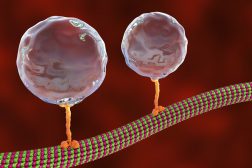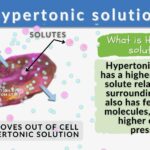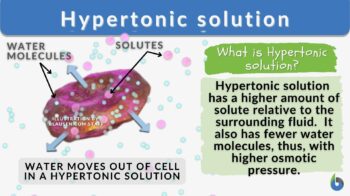
Hypertonic solution
n., plural: hypertonic solutions
[ˌhaɪpəˈtɒnɪk səˈl(j)uːʃən/]
Definition: A solution that has higher osmotic pressure
Table of Contents
Hypertonic Solution Definition
Hypertonic solution is a relative term that describes the solution having a higher amount of solute concentrations as compared to the surrounding fluid. As a result of high solute concentration and low solvent concentration with respect to another solution, a concentration gradient is generated that propels the movement of the liquid until the two solutions achieve similar solute and solvent concentrations. Etymologically, hypertonic comes from ‘hyper’, meaning “high”, and ‘tonic’, which refers to tonicity.
Hypertonic solutions refer to solutions having high osmolarity. Osmolarity refers to the number of solute molecules per solution volume or weight.
Another way to define hypertonic solutions is this: Solutions having higher osmotic pressure are hypertonic solutions.
In simpler terms, solutions having higher solute concentration and low water content relative to the surrounding fluid are referred to as hypertonic solutions.
Watch this vid about the types of solutions, including hypertonic solutions:
Biology definition:
A hypertonic solution is a solution that has higher osmotic pressure (or has more solutes) than another solution to which it is compared. When a cell’s cytoplasm is bathed in a hypertonic solution the water will be drawn out of the cell and into the solution by osmosis. If water molecules continue to diffuse out of the cell, it will cause the cell to shrink.
See also: isotonic solution; hypotonic solution
Hypertonic Solution Overview
Briefly, a solution is made up of two components. They are solute and solvent. Solute dissolved in the solvent makes a solution. Depending upon the concentration of solutes or the number of solute particles, solutions can be classified into three types. They are hypertonic, isotonic, and hypotonic solutions.
-
Three types of solutions
The solute and solvent concentration in a solution determines their movement according to the concentration gradient. Tonicity is the effective osmotic pressure gradient across a semipermeable membrane. Thus, the movement across the semipermeable membrane is concentration gradient-dependent.
In a biological system, a solution is usually surrounded by a semipermeable membrane. For example, the cytosol is surrounded by the cell membrane. Hence, hypertonic cytosol will be surrounded by a hypotonic solution around it.
In the process of osmosis, water movement occurs across a semipermeable membrane as per the concentration gradient. The water molecules move from a high concentration to a low concentration area until isotonicity is achieved — that is, in which about equal concentrations are achieved.
- Isotonic solutions are the ones having similar tonicity or osmotic pressure. Two solutions are the isotonic solution when there is no difference in their effective osmotic pressure and hence there is no net movement of solute/solvent across them. It can be said, therefore, that the concentration gradient is the driving force or the movement of solute/solvent.
- Solutions having higher solute concentration and low water/solvent content are the hypertonic solutions
- Solutions having lower solute concentration and high water/solvent content are hypotonic solutions.
-
Hypertonicity vs. hypotonicity
Hypertonicity is always relative to the surrounding fluid or external solution. Accordingly, if a solution is hypertonic then the surrounding fluid would be hypotonic. Take for example this scenario: if cellular cytosol is hypertonic then the fluid around it would be hypotonic. Subsequently, depending upon the concentration gradient the movement of solute/solvent will occur till an equilibrium is achieved.
In line with this, if a cell with hypertonic cytosol is placed in the hypotonic solution then it will swell as water will move from outside towards the cytosol. In contrast, if a cell is placed in the hypertonic solution then, water will move out of the cell resulting in cell shrinkage (Figures 1 and 2).
Let us understand this using red blood cells as an example:
The red blood cells when placed in body fluids having similar ionic concentration will retain their shape and structure as the body fluids will be isotonic to its cytoplasm. However, when red blood cells are placed in plain water, the cells will swell. This is because plain water would be hypotonic as compared to the cytosol/cytoplasm of the red blood cells.
The cytoplasm of the red blood cells would be hypertonic and hence water will move from the hypotonic solution into the cell resulting in the swelling of the cell. If the influx of water continues, this could eventually lead to a cell burst.
In contrast, red blood cells when placed in the salt solution, the cell would shrink and shrivel. This is due to the fact that salt solution is hypertonic as compared to the cytosol. The cytosol of red blood cells would be hypotonic as compared to the salt solution resulting in loss or movement of water from the cell to its surrounding leading to cell shrinkage and shrivel.
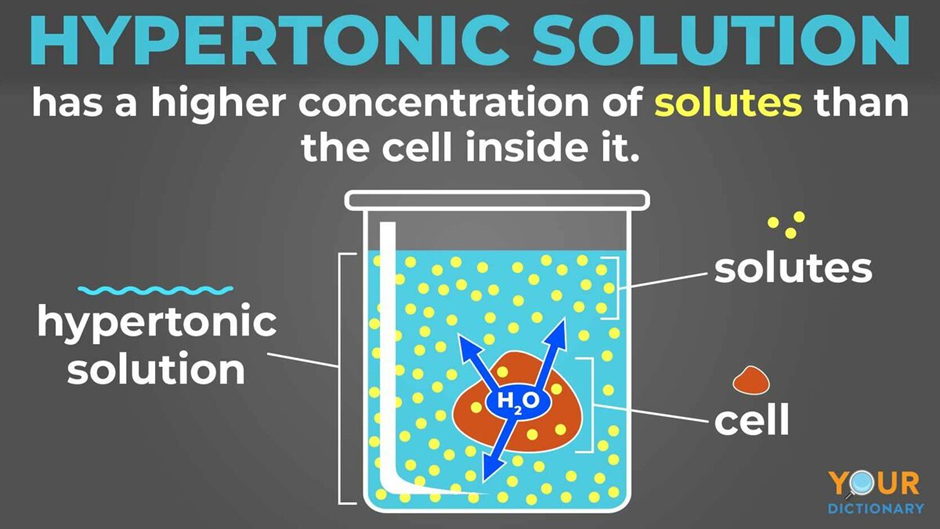
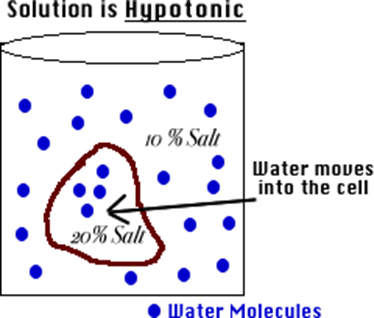
-
- Solutions vs. Body Fluid
Since tonicity is a relative term, some examples of hypertonic solutions compared to body fluids or baseline fluids, are as follows:
» Lemonade
» Orange juice
» Saltwater/ocean water
» Beer or Alcoholic beverages
Some examples of isotonic and hypotonic solutions with respect to body fluids are:
» plain distilled water is an example of a hypotonic solution
» normal saline and Ringer’s solution is an example of an isotonic solution
-
Hypertonic solutions vs. Hypotonic solutions
Here, let us understand the difference between hypertonic solutions and hypotonic solutions.
Table 1: Hypertonic solutions vs. Hypotonic solutions |
|
|---|---|
| Hypertonic solutions | Hypotonic solutions |
| High solute concentration or higher concentration of solute particles | Low solute concentration or lower concentration of solute particles |
| Low water concentration | High water concentration |
| A cell placed in a hypertonic solution will shrink | A cell placed in a hypotonic solution will swell |
| A cell placed in hypertonic solutions loses out the water | A cell placed in hypotonic solutions takes up the water |
| The solution has a high osmotic pressure | The solution has a low osmotic pressure |
| Useful in food preservation | Not used in food preservation |
| The plant cells when placed in a hypertonic solution will undergo plasmolysis while animal cells shrink. | A plant cell having a rigid cell wall, when placed in a hypotonic solution will become turgid. Animal cells will swell. And due to a lack of cell walls, animal cells may eventually burst from too much water influx. |
Data Source: Dr. Amita Joshi of Biology Online
Examples
Here are some examples of hypertonic solutions in the context of biology.
-
Human Kidney
The human brain has an osmoregulation center that possesses osmoreceptor proteins. These osmoreceptor proteins keep a check of the osmotic balance of the cells of the body. When the cells are exposed to a hypertonic environment, it is indicative of less amount of water in the blood. This stimulates the hypothalamus in the brain to release the hormone vasopressin, which in turn induces the kidney to increase the permeability of the renal membrane. As a result, a higher amount of water reabsorption occurs from the kidney which increases the fluid/water amount in the blood. The addition of water in the bloodstream makes it isotonic and thus maintains the integrity of the cell.
-
Sea Turtle Osmoregulation
Seawater turtles and freshwater turtles both are exposed to different osmolarity. Sea water is highly hypertonic, while in comparison, fresh water is hypotonic. Hence, for the normal functioning of the seawater turtle, their cell cytoplasm has higher hypertonicity as compared to the seawater. Hence, if a freshwater turtle is exposed to seawater, the cytosol would be highly hypotonic as compared to the surrounding seawater. This difference in osmolarity would result in the loss of water from the freshwater turtle, making it difficult for it to survive in seawater.
To adapt to such conditions, sea animals including sea turtles, have developed mechanisms to get rid of excess salt from the body. Salt from the digestive tract is directed towards the bloodstream, increasing the salt concentration in the physiological fluid of the turtles. The increase in the salt concentration in the blood makes it highly hypertonic and thus sea turtles do not lose excess water from the body. Once the excess salt reaches the salt gland of the sea animal, it is eventually removed from the body.
-
Plants in Hypertonic Solution
Turgidity is extremely important for plants to stand erect and retain their structure. Turgidity is the pressure created by the water, inside the cell, on the cell wall. To attain turgidity, the majority of plants prefer a hypotonic environment. This is because exposure to a hypotonic environment results in the movement of water from the external environment to the cells. As a result of which the cells become turgid. This is also the reason for the drooping of leaves when plants are not given a suitable amount of water.
However, a group of plants has adapted to live in harsh salty water like in sea marshes and mangroves. These plants are exposed to extremely high salt concentrations or hypertonic environments. A normal plant in such a hypertonic environment will not be able to survive. However, halophytes (the plants that have adapted to live in a salty harsh environment) have developed a mechanism to thrive in high-salt concentration environments.
These plants are capable of increasing the salt concentration in the root cells as a result of which, the cytosol of the root cells becomes hypertonic. Hence, due to concentration and osmolarity gradient, water movement occurs from the hypotonic solution towards the hypertonic solution i.e., from the external environment towards the root cell. The excess salt is either stored within the root cell or is transferred to the leaves from where they can be eliminated via secretary glands.
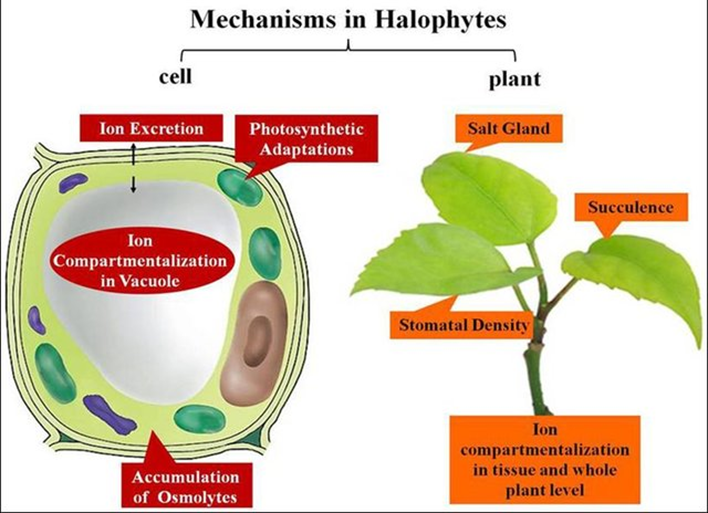
A Cell In Hypertonic Solution
Cells have a semipermeable plasma membrane that selectively allows the movement of solute through it. As a result, for the movement of certain solutes, the cell has to utilize energy i.e., active permeation. Also, there are certain channels (like, aquaporins) that allow the path for the movement across the membrane. Though, solvent/water can freely move across the membrane. In the majority of cells, the cytosol is hypertonic as a result, the water moves into the cell. Free water movement is essential for several physiological functioning. Hence, the majority of cells try to maintain the hypertonicity of the cytosol.
This balance, though seemingly very simple, is very essential for the normal physiological functioning of the living cells. This movement of solvent/water across the semipermeable membrane forms the basis of the basic functioning of the nervous system, digestive tract, kidney functioning, etc. Water and nutrient balance is eventually maintained in the body and remains in equilibrium because of this basic function.
On the contrary, when cells are placed in hypertonic solutions like seawater, water moves against the concentration gradient i.e., from the cell towards the solution. In such a hypertonic environment, cells utilize aquaporins. Cells are highly adaptogenic and their survival mechanism or osmotolerance mechanism includes the maintenance of hypertonicity by gathering up all the osmolytes and increasing their concentration within the cytosol. Na, Cl, and K are some of the ions that get accumulated in the cytosol, making it hypertonic. Also, cells try to generate and increase the number of protein channels to cope with the osmolarity changes. When the cell starts to shrink it creates stress within the cell and to cope with the stress, sodium, potassium ion channels and ATPases are activated. For the ‘Fast’ recovery, transporter ion channels are activated while in case of ‘slow’ adaptation or for a chronic condition, gene modification for the production of protein and for the accumulation of solutes or osmolytes takes place. TonEBP (tonicity-responsive enhancer-binding protein), Or NFAT5 /OREBP are some of the primary transcription factors that promote the accumulation of osmolytes in the cells.
In equilibrium or steady state, the cytosol of the cell is rich in large molecular weight colloidal components like proteins and phosphates. These high molecular weight substances can not cross the semipermeable biological membrane. The inability of these large molecules in the cytosol creates as Donnan effect. The Donnan effect defines the hypertonicity of cytosol that occurs due to the inability of high molecular weight substances to cross the semipermeable membrane which leads to the higher concentration of solute in the cytosol. This higher concentration eventually creates osmotic forces that drive the movement of substances across the biological membrane.
Uses of Hypertonic Solution
Here are the uses of hypertonic solutions in different fields:
-
Food preservation
As we know from the above discussion in a hypertonic solution, cell shrink due to the loss of water from the cell and this forms the basis of the usage of hypertonic solution in food preservation. Dehydration of cells is used to preserve fruits and food.
The same rationale is utilized in pickle formation. High salt concentration in pickles forms the hypertonic solution and thus preserves food. Because of the high salt content of the fluid, this hypertonic environment can effectively inhibit the growth of microorganisms, especially bacteria that could otherwise act on the food, which leads to food spoilage. Water from bacterial cells is drawn out. This makes them lose their ability to function well and ultimately leads to their death. Salt, sugar, or other preservatives are the commonly used solutes to create a hypertonic solution for food preservation.
-
Reverse osmosis
Although hypertonic solutions are not directly involved in the process of water purification and desalination by reverse osmosis, they have an indirect role related to the concentration gradient that is necessary for the process to proceed. As noted earlier, the concentration gradient is formed between solutions separated by a semipermeable membrane and is the driving force for the movement of water molecules. By nature, water molecules tend to equalize their concentrations between two fluids by moving across the semipermeable membrane by osmosis. And in reverse osmosis, a high-pressure pump is used to force the water to flow across the semipermeable membrane against the natural osmotic gradient while blocking the passage of solutes (and other impurities). As a result, one side of the membrane is, thus, hypotonic with respect to the other side, which is hypertonic (specifically, the concentrated brine solution). The hypertonic nature of the brine contributes by creating a concentration gradient that facilitates the separation of the resulting “freshwater” from the “saltwater” during desalination.
-
Medical use of hypertonic fluids
Hypertonic fluids are administered, via the parenteral route i.e., injection/infusion, and have higher sodium concentration as compared to the blood and intestinal fluid. The 3% and 5% hypertonic saline solutions are approved by FDA for the treatment of increased intracranial pressure and hyponatremia (i.e., deficiency of sodium or sodium concentration below 135 mEq/L in the body).
Due to its hypertonic nature, this solution creates an osmotic gradient and drives out fluid from the interstitial space to the intravascular spaces, thereby increasing the intravascular volume. The increased intravascular volume results in elevated stroke volume (SV), mean arterial pressure (MAP), and cardiac output (CO).
Hypertonic solutions can also result in the release of vasopressin hormone that stimulates the kidney to reduce the water loss from the body. Apart from the hypertonic saline solution, hypertonic mannitol solution is also used. Hypertonic mannitol solution is FDA-approved for reducing intracranial pressure and intraocular pressure. However, hypertonic solutions should be avoided in medical conditions wherein there is an accumulation of sodium ions and increased fluid, as in congestive heart failure or renal insufficiency.
Although every cell tries to maintain hypertonicity, however acute hypertonicity can lead to certain medical complications which can be fatal. Two such hypertonic conditions are- hyperglycemia and hypernatremia. Hyperglycemia is increased plasma glucose level in the body as seen in diabetes while hypernatremia is excess body sodium as compared to body fluid composition. Excess loss of water and increased salt consumption can lead to hypernatremia. Treatment with a hypotonic solution is used for the management of hypernatremia. Both of these medical conditions can be fatal and needs immediate medical attention.
Did you know…
… that hypertonic solutions are better than plain water if you want to preserve your cut flowers?
Yes! It is, in fact, a common practice. If you want to extend the vase life of your cut flowers, consider using a hypertonic solution over plain water. There are commercially available floral preservatives for this purpose. Or you may use the common table sugar (sucrose) at home as an alternative. To make your own hypertonic solution for your cut flowers, dissolve about two tablespoons of sugar in one liter of lukewarm water. Transfer to a clean vase. Before you place your cut flowers trim about an inch off the bottom of each stem at a diagonal angle (for better absorption). Make sure no leaves are submerged to further minimize bacterial contamination. This technique will keep your cut flowers fresh longer as it will…
✓ Enhance water uptake (via osmosis) in the unsubmerged portion
of cut flowers, especially the flower cells
✓ Provide nutrients (sugar)
✓ Reduce bacterial growth
Take the Hypertonic Solution – Biology Quiz!
References
- Argyropoulos, C., Rondon-Berrios, H., Raj, D. S., Malhotra, D., Agaba, E. I., Rohrscheib, M., Khitan, Z., Murata, G. H., Shapiro, J. I., & Tzamaloukas, A. H. (2016). Hypertonicity: Pathophysiologic Concept and Experimental Studies. Cureus, 8(5), e596. https://doi.org/10.7759/cureus.596
- · Carvalho, W. B. D. (2003). Hypertonic solutions for pediatric patients. Jornal de pediatria, 79, S187-S194.
- · Rondon-Berrios, H., Argyropoulos, C., Ing, T. S., Raj, D. S., Malhotra, D., Agaba, E. I., Rohrscheib, M., Khitan, Z. J., Murata, G. H., Shapiro, J. I., & Tzamaloukas, A. H. (2017). Hypertonicity: Clinical entities, manifestations and treatment. World journal of nephrology, 6(1), 1–13. https://doi.org/10.5527/wjn.v6.i1.1
- · Tyagi, R., Donaldson, K., Loftus, C. M., & Jallo, J. (2007). Hypertonic saline: a clinical review. Neurosurgical review, 30(4), 277–290. https://doi.org/10.1007/s10143-007-0091-7
©BiologyOnline.com. Content provided and moderated by Biology Online Editors.

